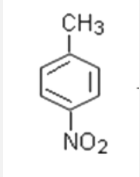Identify the final product (Z) in the following sequence of reactions :
Me2C=O+HCN→(X)H3O+−−−→(Y)H2SO4−−−→
(CH3)2C(OH)COOH
CH2=C(CH3)COOH
HOCH2CH(CH3)COOH
CH3CH=CHCOOH
The correct Answer is:B
To identify the final product (Z) in the given sequence of reactions, let's break down the steps involved:
Step 1: Identify the starting compound
The starting compound is dimethyl ketone, which can be represented as:
Me2C=O
This can be written as:
CH3C(=O)CH3
Step 2: Reaction with HCN
When dimethyl ketone reacts with hydrogen cyanide (HCN), the nucleophilic cyanide ion (CN⁻) attacks the carbonyl carbon. The reaction can be represented as follows:
CH3C(=O)CH3+HCN→CH3C(CN)(OH)CH3
This results in the formation of a cyanohydrin (X):
X=CH3C(CN)(OH)CH3
Step 3: Hydrolysis of X
Next, when the cyanohydrin (X) is treated with hydronium ions (H₃O⁺), the cyanide group (CN) is hydrolyzed to a carboxylic acid (COOH):
CH3C(CN)(OH)CH3+H3O+→CH3C(COOH)(OH)CH3
This product is denoted as Y:
Y=CH3C(COOH)(OH)CH3
Step 4: Reaction with H₂SO₄
When Y is treated with sulfuric acid (H₂SO₄), dehydration occurs. The hydroxyl group (OH) can be protonated, leading to the formation of a carbocation:
CH3C(COOH)(OH)CH3H2SO4→CH3C+(COOH)CH3+H2O
After the loss of water, we obtain a double bond:
CH3C(=C)CH3COOH
Step 5: Final product Z
The final product Z after the dehydration process is:
Z=CH3C(=C)CH3COOH
This can also be represented as:
Z=CH2=CHCOOH (with a methyl group attached)
Summary of Products
- X: CH3C(CN)(OH)CH3
- Y: CH3C(COOH)(OH)CH3
- Z: CH2=CHCOOH
The starting compound is dimethyl ketone, which can be represented as:
Me2C=O
This can be written as:
CH3C(=O)CH3
When dimethyl ketone reacts with hydrogen cyanide (HCN), the nucleophilic cyanide ion (CN⁻) attacks the carbonyl carbon. The reaction can be represented as follows:
CH3C(=O)CH3+HCN→CH3C(CN)(OH)CH3
This results in the formation of a cyanohydrin (X):
X=CH3C(CN)(OH)CH3
Next, when the cyanohydrin (X) is treated with hydronium ions (H₃O⁺), the cyanide group (CN) is hydrolyzed to a carboxylic acid (COOH):
CH3C(CN)(OH)CH3+H3O+→CH3C(COOH)(OH)CH3
This product is denoted as Y:
Y=CH3C(COOH)(OH)CH3
When Y is treated with sulfuric acid (H₂SO₄), dehydration occurs. The hydroxyl group (OH) can be protonated, leading to the formation of a carbocation:
CH3C(COOH)(OH)CH3H2SO4→CH3C+(COOH)CH3+H2O
After the loss of water, we obtain a double bond:
CH3C(=C)CH3COOH
The final product Z after the dehydration process is:
Z=CH3C(=C)CH3COOH
This can also be represented as:
Z=CH2=CHCOOH (with a methyl group attached)
- X: CH3C(CN)(OH)CH3
- Y: CH3C(COOH)(OH)CH3
- Z: CH2=CHCOOH
Similar Questions
Identify the final product (Z) in the following sequence of reactions. CH3NH2CH3l Excess−−−−−−−→(X)AgOH−−−→(Y)Δ−−→(Z)+CH3OH
View SolutionIdentify the final product in that follow sequence of reactions.
CH2=CH2Br2−−→(X)KCN−−→(Y)H3O+−−−→(Z)
View SolutionThe end product (B) in the following sequence of reactions is CH3ClKCN−−→AH2O/H+−−−−−→B
View SolutionThe final product (Z) is the following sequence of reaction CH3CH2NH2HNO2−−−→(X)Socl2−−→(Y) is NH3−−→(Z)
View SolutionIdentify the product 'Z' in the following sequence of reactions.
CH3CNNa+C2H5OH−−−−−−−−→XHNO2−−−→H2OYK2Cr2O7−−−−−→H2SO4Z
View SolutionIdentify the product (E) in the following sequence of reactions.
 Br2−−→ASn/HCl−−−−→BNaNO2/HCl−−−−−−−−−−→273−278KCH2O/H3PO2−−−−−−−→DKMnO4−−−−−−−→OH−E
Br2−−→ASn/HCl−−−−→BNaNO2/HCl−−−−−−−−−−→273−278KCH2O/H3PO2−−−−−−−→DKMnO4−−−−−−−→OH−E
View SolutionThe final product (Y) of the following reaction is:
C2H4Br2−−→ X Ph3SnH−−−−→ Y
View SolutionWhat is (Z) is the following sequence of reaction?
HC≡CH(i)2NaNH2(ii)2CH3I−−−−−−−−−−−−−−→(X)HgSO4,H2SO4−−−−−−−−→(Y)(i)NaOH+Br3(ii)H3O+−−−−−−−−−−−−−−−−→(Z)
View SolutionThe end product (C) of the following sequence of reaction is :
CH≡CH+MeMgBr(1mol)→(A)(i)CO2−−−−−−→(ii)H3O⊕(B)HgSO4/H2SO4−−−−−−−−−→(C).
View SolutionThe final product (X) in the following reaction is
 (i)conc.H2SO4−−−−−−−−−→conc.HNO3−−−−−−→Δ−−→H2O/OH−−−−−−−→(X)
(i)conc.H2SO4−−−−−−−−−→conc.HNO3−−−−−−→Δ−−→H2O/OH−−−−−−−→(X)
View Solution